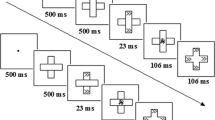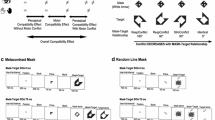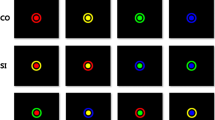Abstract
The current study investigated the mechanism underlying subliminal inhibition using the negative compatibility effect (NCE) paradigm. We hypothesized that a decrease in prime activation affects the subsequent inhibitory process, delaying onset of inhibition and reducing its strength. Two experiments tested this hypothesis using arrow stimuli as primes and targets. Two different irrelevant masks (i.e., a mask sharing no prime features) were presented in succession in each trial to not only ensure that primes were processed subliminally, but also avoid feature updating between primes and masks. Prime/target compatibility and prime background density were manipulated in Experiment 1. Results showed that under subliminal inhibitory condition, the NCE disappears when the density increases (i.e., pixel density in the prime’s background of 25 %) in Experiment 1. However, when we fixed the prime’s background at the density of 25 % and manipulated prime/target compatibility as well as inter-stimuli-interval (ISI) between mask and target in Experiment 2, behavioral results showed marginally significant NCEs in the 150-ms ISI condition. Electrophysiological evidence showed the lateralized readiness potential for compatible trials was significantly more positive than that for incompatible trials during the two consecutive time windows (i.e., 400–450 and 450–500 ms) in the 150-ms ISI condition. In addition, the NCE size was significant smaller in Experiment 2 than in Experiment 1. All of the results support predictions of the continuous subliminal inhibitory mechanism hypothesis which posits that decreases in prime activation strength lead to delay in inhibitory onset and decline in inhibitory strength.





Similar content being viewed by others
Notes
The visibility of a prime can be influenced by a mask; prime visibility is low when a mask is effective. Since theoretically this is a factor in self-inhibition theory, it is important to assess prime visibility. Traditionally, prime visibility was tested using a forced-choice task. The task is conducted using primes and masks in a traditional NCE procedure, except no target is presented. Participants are asked to respond to the directions of the primes after the masks’ presentation, if the accuracy of the forced-choice task does not significantly differ from chance level (50 %), this indicates that the masks effectively cease the initial activation of the primes.
Prior to the initiation of voluntary movements, a negative potential can be observed over the human scalp, called the readiness potential. It is larger over the left than the right motor area to right-hand movements and vice versa for left-hand movements. The moment-by-moment difference between the EEG activity over sensorimotor cortical areas contralateral and ipsilateral to the responding hand is called the LRP. This potential can be observed not only with voluntary movements but also, of importance here, with subliminal prime-induced movements.
References
Boy F, Sumner P (2010) Tight coupling between positive and reversed priming in the masked prime paradigm. J Exp Psychol Hum Percept Perform 36:892–905
Boy F, Husain M, Singh KD, Sumner P (2010) Supplementary motor area activations in unconscious inhibition of voluntary action. Exp Brain Res 206:441–448
Cole G, Kuhn G (2010) What the experimenter’s prime tells the observer’s brain. Atten Percept Psychophys 72:1367–1376
Eimer M (1999) Facilitatory and inhibitory effects of masked prime stimuli on motor activation and behavioural performance. Acta Psychol 101:293–313
Eimer M, Schlaghecken F (1998) Effects of masked stimuli on motor activation: behavioral and electrophysiological evidence. J Exp Psychol Hum Percept Perform 24:1737–1747
Eimer M, Schlaghecken F (2002) Links between conscious awareness and response inhibition: evidence from masked priming. Psychon Bull Rev 9:514–520
Eimer M, Schlaghecken F (2003) Response facilitation and inhibition in subliminal priming. Biol Psychol 64:7–26
Houghton G, Tipper SP (1994) A model of inhibitory mechanisms in selective attention. In: Dagenbach D, Carr TH (eds) Inhibitory processes in attention, memory, and language. Academic Press, Inc., San Diego, pp 53–112
Lamme VA, Roelfsema PR (2000) The distinct modes of vision offered by feedforward and recurrent processing. Trends Neurosci 23:571–579
Lingnau A, Vorberg D (2005) The time course of response inhibition in masked priming. Percept Psychophys 67:545–557
Lleras A, Enns JT (2004) Negative compatibility or object updating? A cautionary tale of mask-dependent priming. J Exp Psychol Gen 133:475–493
Sato W, Okada T, Toichi M (2007) Attentional shift by gaze is triggered without awareness. Exp Brain Res 183:87–94
Schlaghecken F, Eimer M (2000) A central-peripheral asymmetry in masked priming. Percept Psychophys 62:1367–1382
Schlaghecken F, Eimer M (2002) Motor activation with and without inhibition: evidence for a threshold mechanism in motor control. Percept Psychophys 64:148–162
Schlaghecken F, Eimer M (2004) Masked prime stimuli can bias “free” choices between response alternatives. Psychon Bull Rev 11:463–468
Schlaghecken F, Eimer M (2006) Active masks and active inhibition: a comment on Lleras and Enns (2004) and on Verleger, Jaskowski, Aydemir, van der Lubbe, and Groen (2004). J Exp Psychol Gen 135:484–494
Sumner P, Nachev P, Morris P, Peters AM, Jackson SR, Kennard C, Husain M (2007) Human medial frontal cortex mediates unconscious inhibition of voluntary action. Neuron 54:697–711
Acknowledgments
This research was supported by a grant from Natural Science Foundation of China (31371026) to Yonghui Wang. We thank Prof. Geoff Cole and the other anonymous reviewer for helpful comments on earlier versions of this work and Prof. Kevin Miller from University of Michigan for polishing the language of the final revision.
Author information
Authors and Affiliations
Corresponding author
Rights and permissions
About this article
Cite this article
Liu, P., Chen, X., Dai, D. et al. A subliminal inhibitory mechanism for the negative compatibility effect: a continuous versus threshold mechanism. Exp Brain Res 232, 2305–2315 (2014). https://doi.org/10.1007/s00221-014-3925-x
Received:
Accepted:
Published:
Issue Date:
DOI: https://doi.org/10.1007/s00221-014-3925-x




